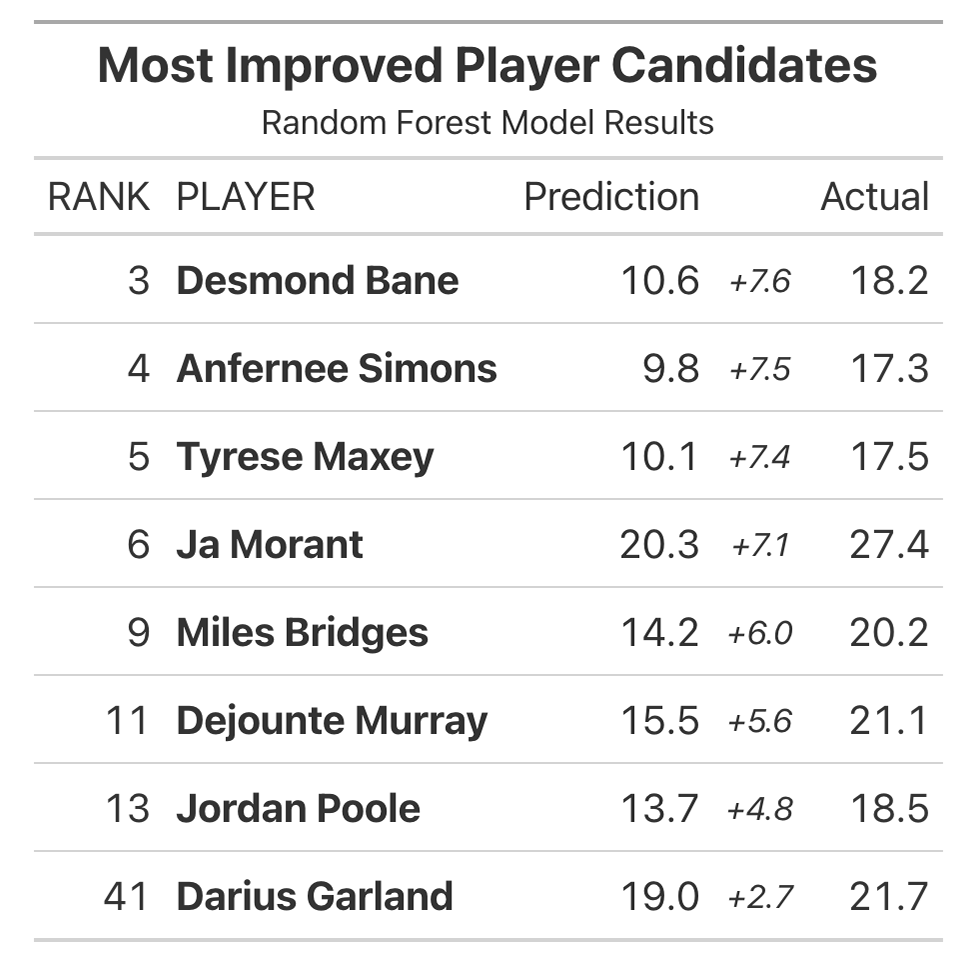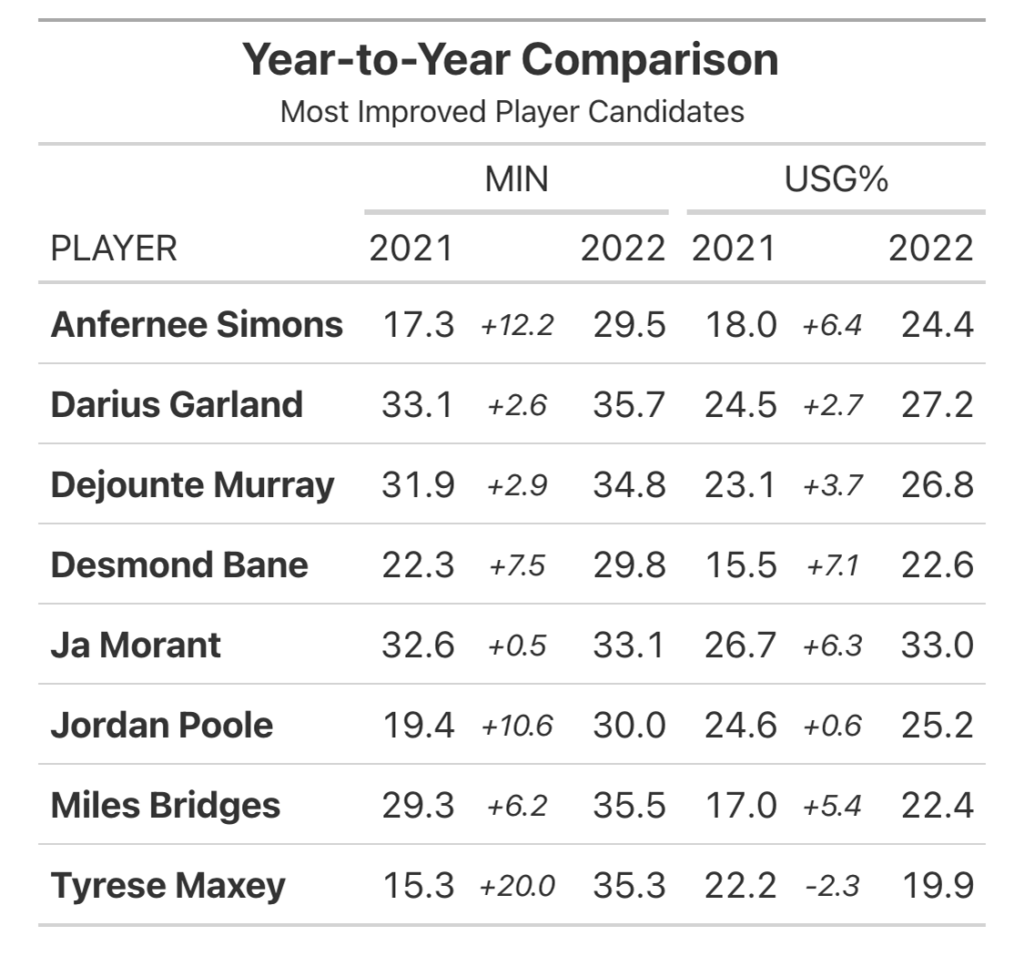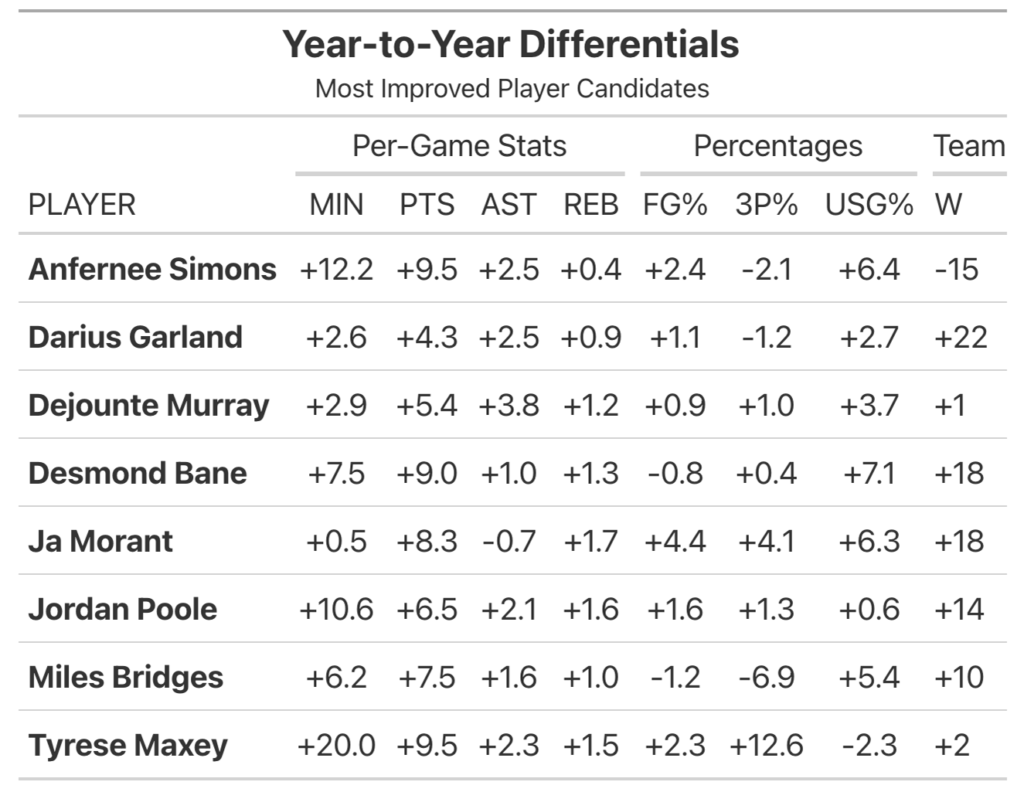1% Better: Reconsidering the Most Improved Player Award
May 2022
Introduction
About a month ago, Ja Morant was named the NBA’s Most Improved Player after soaring into superstar status and elevating the Memphis Grizzlies from play-in territory to the No. 2 seed in the Western Conference and second-best record in the league. This should come as no surprise, as the third-year point guard has repeatedly played at an all-star level while flashing MVP potential.
This should come as no surprise.

Ja Morant’s improvement was nothing short of impressive, but did we see this coming? The former second-overall pick in the 2019 NBA Draft has been the decisive leader of the Grizzlies for the entirety of his brief career, and a breakout season was undoubtedly anticipated if not expected, which begs the question: is the current criteria for Most Improved Player fundamentally flawed?
Expectational Model
In order to answer that question, we need to start with how we currently evaluate award candidates. Are they more productive? More efficient? How are they influencing team success, if at all? By these standards, Morant checks all the boxes, but perhaps it’s time we place more emphasis on the extent to which players outperform expectations.

Luckily – and not by coincidence – I just created an expectational model that predicts scoring output that we can use to see who overperformed the most. For the sake of simplicity, let’s restrict our analysis to the following award candidates. To the left shows each player and their respective league rank by residuals – their projected output subtracted from their actual output. By ranking players based on their residual, we can effectively control for volume and isolate the change in output, which is ultimately what the award is all about.
To judge the award based off of this ranking alone would be impractical, so let’s unpack this a little further. To crown one of these eight players as the Most Improved Player, we should address the questions posed earlier; are they more productive and efficient than the previous season? And how are they influencing team success, if at all?
Who Produced More Than Last Season?

The small dots indicate 2021 statistics and the large dots indicate 2022 statistics; the faded dots indicate the model’s projection.

All candidates substantially increased their scoring output and surpassed the model’s projected points, with Simons (+9.5), Maxey (+9.5), and Bane (+9.0) improving the most.
Murray (+3.8) stands out as the most improved distributor, while Garland (+2.5), Simons (+2.5), Maxey (+2.3), and Poole (+2.1) all increased their average by at least two assists; all other candidates except Morant increased their assist average.
All candidates increased their rebound average with no single player making a notable improvement.
Who shot More efficiently Than Last Season?

The small dots indicate 2021 statistics and the large dots indicate 2022 statistics.

Morant (+4.4%) had the largest increase in field goal percentage, with Simons (+2.4%) and Maxey (+2.3%) trailing him. Bridges (-1.2%) and Bane (-0.8%) were the only players in the group to shoot worse from the field this season.
Maxey (+12.6%) recorded a huge improvement from three-point range, way ahead of Morant (+4.1%), while Bridges (-6.9%), Simons (-2.1%), and Garland (-1.2%) all regressed.
Whose role changed from last season?

The small dots indicate 2021 statistics and the large dots indicate 2022 statistics.

All candidates essentially logged 30+ minutes per game this season, with Maxey (+20.0) and Poole (+10.6) getting much more playing time, followed by Bane (+7.5) and Bridges (+6.2).
Interestingly, Maxey’s usage rate (-2.3%) actually decreased, while that of Bane (+7.1%), Simons, (+6.4%), Morant (+6.3%), and Bridges (+5.4%) all substantially increased.
Whose team was more successful than last season?


The Cavaliers (+22) increased their win total the most, with the Grizzlies (+18), Warriors (+14), and Hornets (+10) right behind them. The success of the Spurs (+1) and 76ers (+2) remained constant, while the Trail Blazers (-15) lost a lot of games.
The verdict
Putting it all together, we have eight candidates, and the evidence encompasses per-game averages, shooting percentages, and team wins – as well as an expectational model for scoring output. So who was the Most Improved Player?

That distinction should belong to Tyrese Maxey. Compared to last season, he led the league in scoring differential (+9.5), and increased his efficiency across the board to the tune of an insane 12.6% rise in three-point percentage. While other candidates made similarly impressive improvements, what differentiates Maxey is that he played 20 more minutes this season yet was the only award candidate to see a drop in usage rate. He was less ball-dominant and still managed to put up great numbers. And to address the 76ers only winning two more games this season, there was plenty of turmoil surrounding the Ben Simmons fallout and the James Harden acquisition that affected the whole team and overshadowed any of Maxey’s achievements in the media. Lastly, Maxey outperformed expectations and outranked all but four players in the league by model residuals.
Bottom Line: Tyrese Maxey was the league’s most improved scorer and shooter on limited usage.
Conclusion
Somehow, Tyrese Maxey wasn’t even a finalist for Most Improved Player, as the three spots were taken by Morant, Garland, and Murray. Perhaps this speaks to a larger conversation about how the media can control narratives; for years, popular teams such as the Lakers or Warriors have seen 30-40 nationally televised games every season, while lottery teams such as the Magic or Thunder fail to get national coverage even 5 times a season. Young stars are not getting the media coverage they deserve, while the league’s premier stars get coverage even while injured. As a result, false or embellished headlines arise and drown out the narratives that true basketball fans want to hear; for example, Kevin Durant hasn’t played a game in over a month, yet sports “analysts” and hosts constantly debate his legacy. Maybe the NBA can learn a little and show some more love to the Maxeys of this league.
